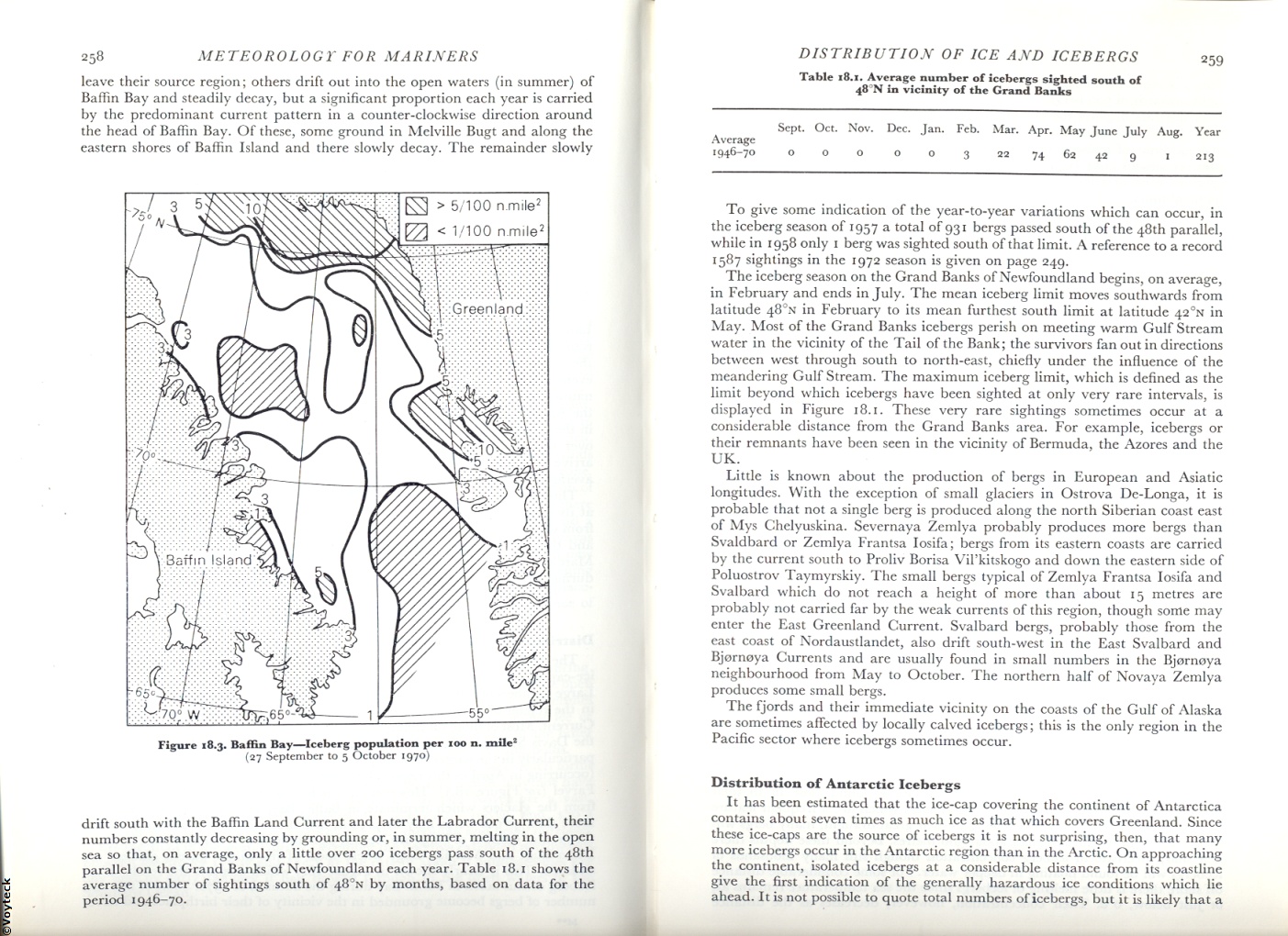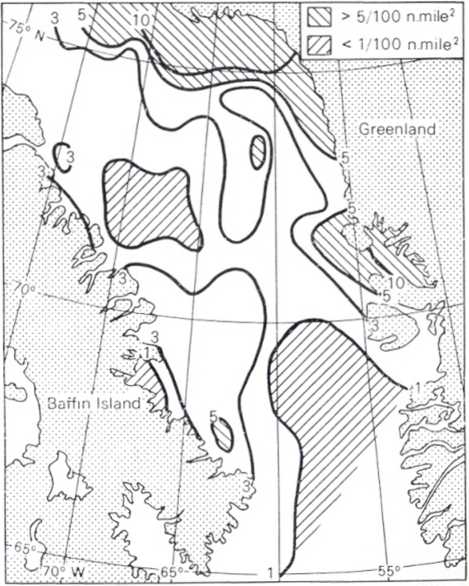258 259 (10)

XIETEOROLOGT FOR MARINERS
258
lcavc thcir sourcc region; others drift out into the open waters (in summer) of BafTin Bay and stcadily dccay, but a significant proportion cach ycar is carried by the predominant currcnt pattern in a counter-clockwise direction around the head of BafTin Bay. Of thcsc, somc ground in Mclvillc Bugt and along the eastern shores of BafTin Island and there slowly decay. The remainder slowly

Figurę 18.3. Bafłin Bay—Iceberg popuiation per 100 n. mile2
(27 Septcmbcr to 5 Octobcr 1970)
drift south with the BafTin Land Current and later the Labrador Currcnt, thcir numbers constantly dccreasing by grounding or, in summer, melting in the open sca so that, on avcragc, only a littlc over 200 iccbcrgs pass south of the 48th parallel on the Grand Banks of Ncwfoundland each year. Tablc 18.1 shows the averagc number of sightings south of 48°N by months, bascd on data for the period 1946-70.
DISTRIBUTION OF ICE AND ICEBERGS
259
Table 18.1. Avcraąe number of icebergs sighted south of 48 N in vicinity of the Grand Banks
Scpt. Oct. Nov. Dcc. Jan. Fcb. Mar. Apr. May Junc July Aug. Ycar
Avcrage
1946-70 o o o o o 3 22 74 63 42 9 1 213
To give some indication of the year-to-year variations which can occur, in the iccberg scason of 1957 a total of 931 bergs passed south of the 48th parallel, while in 1958 only 1 berg was sighted south of that limit. A refercncc to a record 1587 sightings in the 1972 season is givcn on page 249.
The iccberg season on the Grand Banks of Newfoundland begins, on average, in Fcbruary and ends in July. The mcan iccberg limit moves southwards from latitude 48°n in February to its mcan furthest south limit at latitudc 42°N in May. Most of the Grand Banks icebergs perish on mceting warm Gulf Stream water in the vicinity of the Taił of the Bank; the survivors fan out in dircctions between west through south to north-east, chiefly under the influence of the mcandering Gulf Stream. The maximum iccberg limit, which is defined as the limit bcyond which icebergs havc bccn sighted at only vcry rare intcrvals, is displayed in Figurę 18.1. Thcse vcry rare sightings sometimes occur at a considerable distance from the Grand Banks area. For cxample, icebergs or thcir remnants have bcen scen in the vicinity of Bermuda, the Azores and the UK.
Little is known about the production of bergs in European and Asiatic longitudes. With the exception of smali glaciers in Ostrova Dc-Longa, it is probable that not a single berg is produccd along the north Siberian coast east of Mys Chclyuskina. Severnaya Zcmlya probably produces morę bergs than Svaldbard or Zcmlya Frantsa Iosifa; bergs from its eastern coasts are carricd by the currcnt south to Proliv Borisa VTil’kitskogo and down the eastern sidc of Poluostrov Taymyrskiy. The smali bergs typical of Zcmlya Frantsa Iosifa and Svalbard which do not rcach a height of morę than about 15 metres are probably not carricd far by the weak currents of this region, though some may enter the East Greenland Currcnt. Svalbard bergs, probably those from the east coast of Nordaustlandct, also drift south-west in the East Svalbard and Bjornoya Currents and are usually found in smali numbers in the Bjornoya ncighbourhood from May to Octobcr. The northern half of Novava Zcmlya produces some smali bergs.
The fjords and thcir immediate vicinity on the coasts of the Gulf of Alaska are sometimes afTected by locally calvcd icebergs; this is the only region in the Pacific sector whcrc icebergs sometimes occur.
Distribution of Antarctic Icebergs
It has bcen estimated that the ice-cap covcring the contincnt of Antarctica contains about seven times as much icc as that which covcrs Greenland. Since thcse ice-caps are the source of icebergs it is not surprising, then, that many morę icebergs occur in the Antarctic region than in the Arctic. On approaching the contincnt, isolatcd icebergs at a considerable distance from its coastline give the first indication of the gcnerally hazardous icc conditions which lic ahead. It is not possiblc to quotc total numbers of icebergs, but it is likely that a
Wyszukiwarka
Podobne podstrony:
264 265 (10) METEOROLOG! FOR MARINERS 264 speed at the locality in qucstion but also upon the diffe
31 (199) FOR YOUR HOME S:^ę•***$ *- -* (yot/ t£/my type...Tap into the trend for
Socks Great for knee-high socks: A rubber band can be inserted into the band worked in
256 257 (10) 256 METEOROLOGY FOR MARINERS Distribution of Sea Ice at the Time of G
266 267 (10) 266 METEOROLOG! FOR MARINERS An cfTcct which is sometimes ovcrlookcd is that of atmosp
progress test 4 b 2 For ąuestions 1-10, read the. text bełow and think of the word
12vcl01 The slower <^ outside loop for (outer = 1; outer <= 10; outer++) { for (inside = 0; in
2vrc55qf22cpmf45q1s11145 iso chart 2 Table 2: Requirements for marinę residual fuels Characteristi
2vrc55qf22cpmf45q1s11145 ISO CHARTS1 Table 1: Reguirements for marinę distillate fuels Characteris
Wydarzenia W uczenie nagród w konkursachilmowe Laborki" Kreacje-lnnowacje” 6.10; ATK for Linux;
60 (279) 3.3.10. Therapy for the extensor carpi ulnaris. Starting Position: P: Supine; arm flexed ap
FUTURĘ PROSPECTS In 2020, the demand for marinę distillates may be as much as 200-250 million tonnes
for partial changes within the system, the latter demand a radical change of the system itself.10 Th
83 (175) 3.10.3. Therapy for thc scalenus posterior. Starting Position: P: Supine; head and neck bey
Bazy danych 2 - Laboratorium 2 Przykład 10 BEGIN for i in I..&n loop dbmsoutput.putline(i); end
3.5.3 Pętla for for i in rangę(0, 10): print(i, i**2) for i in [3, 5, 7, 8, 9, 11]: if i 7, 2 ==
więcej podobnych podstron